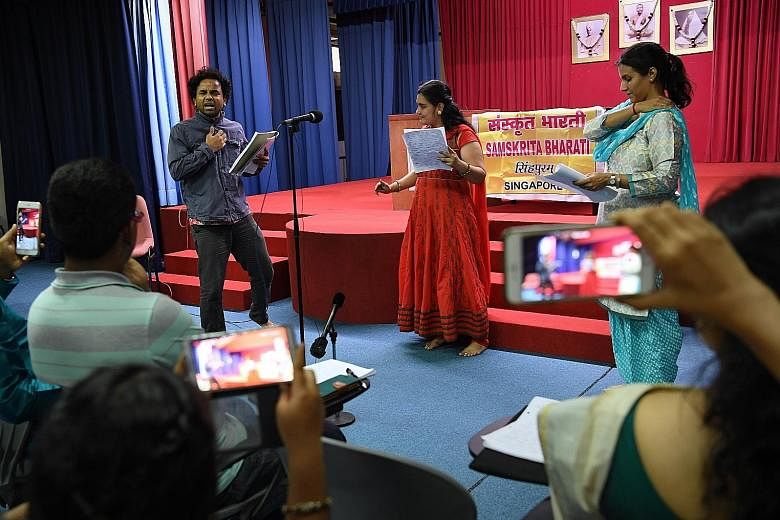Dating back at least 3,000 years, the Sanskrit language has shaped numerous modern cultures in South-east Asia - from Cambodia and Laos, to Malaysia and Indonesia.
Even this country's very name, Singapore, derives from a Sanskrit word: "Sinhapura", or lion city. And "merdeka", the rallying call when the Republic gained independence, has roots in the language.
But modern students and experts of Sanskrit, which hails from what is now South Asia, are few and far between in Singapore.
Over the past few years, a small clutch of lay enthusiasts and university academics have taken it upon themselves to fan the flames of interest in Sanskrit.
The Ramakrishna Mission, a spiritual organisation headquartered in Bartley Road, has held weekly Sanskrit lessons for more than 40 years, said president and monk Vimokshananda, 69.
-
Facts and figures
-
ORIGINS
The first Hindu scriptures, the Vedas, were composed in an early form of Sanskrit from 1,500BC and were passed on orally for the first five centuries.
In the fifth century, the scholar Panini, born in what is now Pakistan, formalised an elaborate system of grammar in Astadhyayi, or "Eight Chapters".
Sanskrit was a courtly language used throughout South and South-east Asia, including the Srivijaya Kingdom in the Malay Archipelago, which flourished from around the 7th to 11th centuries.
NUMBER OF SPEAKERS
As a language now used primarily for religious or academic purposes, Sanskrit is claimed by few as a mother tongue, although there have been nationalist appeals in India.
Attempts to revive it have met with some success. The 3,500 villagers of Mattur, in the southern Indian state of Karnataka, switched from regional mother tongues such as Kannada and Tamil and adopted an all-Sanskrit society in the 1980s.
Dr Srinivasa Malladi, who coordinates Sanskrit study at the Ramakrishna Mission in Singapore, hopes to have about 100 fluent speakers here within the next few years.
WHERE TO LEARN IT
The Ramakrishna Mission, a spiritual organisation in Bartley Road, offers weekly Sanskrit lessons on Sunday afternoons. E-mail office@ramakrishna.org.sg or call 6288-9077.
Samskrita Bharati Singapore, which has ties to a revivalist group based in India, also organises Sanskrit lessons. E-mail sgsamskrita bharati@gmail.com
SANSKRIT LITERATURE
Classics of Sanskrit writing include the Manusmriti, an ancient legal text; the Arthasastra, a guide on how to rule; the Ramayana and Mahabharata epic poems; and Meghaduta, or "Cloud Messenger", a famous work of lyric poetry.
Annabeth Leow
Until a few years ago, a Sanskrit class was more likely to look like a handful of adults engaged in religious study in the organisation's library, because many Hindu and Buddhist scriptures are written and chanted in the language.
Now, the Ramakrishna Mission's programme has expanded to a formal exam-based curriculum with monthly show-and-tell performances that can attract more than 50 participants, Swami Vimokshananda said.
The change is partly thanks to the efforts of Dr Srinivasa Malladi, 44, a psychiatrist at the Institute of Mental Health.
Originally from India, he spent close to a decade living in Britain, where he picked up the language through a Bangalore-based group called Samskrita Bharati that seeks to revive the language, including inventing words for modern conversation - such as "antarjal" for Internet and "sanganakam" for computer.
When he came to Singapore for work seven years ago, Dr Malladi began working with the Rama- krishna Mission to adopt the Samskrita Bharati curriculum, which comprises four levels that each takes six months to get through.
As students progress, they take on the role of tutor for learners who are just starting out.
Reflecting the importance of Sanskrit to the Indian diaspora, the Global Indian International School has made Sanskrit a compulsory subject for its 1,800 primary school pupils in Singapore, using textbooks from India's National Council of Educational Research and Training.
Dr Malladi said that in the spirit of a Sanskrit adage - "Vasudhaiva kutumbakam" (the world is one family) - he hopes the language will appeal to people besides Indian Hindus seeking a deeper understanding of their faith.
Not all Indian languages trace their roots to Sanskrit, especially in the south, but its grammar and vocabulary have influenced many languages it was in contact with - from Khmer to Malay.
Indeed, from a secular vantage point, historians and philosophers intrigued by the classical texts and thinking of the ancient world also learn Sanskrit.
Yale-NUS College undergraduates Nicholas Lua and Vincent Lee, both 22, have had a chance to explore the language.
They are in their first year of language study and are classmates in an online class offered through their school's partnership with Yale University in the United States.
They were introduced to Sanskrit by Yale-NUS Assistant Professor Malcolm Keating, whose expertise is in how the Indian philosophical tradition treats language.
One advantage students in Singapore have is exposure to multiple languages, said Prof Keating, 38, who previously taught Sanskrit in Texas.
Mr Lua, a history major who has also studied Latin, said the huge geographical and temporal distance between his class and the works it studies does not deter - but even piques - his fascination with the ancient tongue.
"We live in such a disenchanted world. It's interesting to read about mythical beings and people living in a world where the gods were very present."
Assistant Professor Alastair Gornall, 31, who teaches ancient philosophy at the Singapore University of Technology and Design, said there can be a depth to learning Sanskrit in a region heavily influenced by the language.
The British historian, who specialises in South and South-east Asian religious studies, pointed out that familiar place names in Singapore can trace their roots to Sanskrit - for example, the Malay word "istana", or palace, comes from "asthana", while Sentosa is derived from the Sanskrit word "samtosa", which means pleasing.
Students in South-east Asia have a proximity to the language that they might not have if they learnt Sanskrit in the West.
Still, the impact of Sanskrit on the region sometimes goes unrecognised.
"I actually thought Singapura was Malay, but it turns out it's from Sanskrit - I'm kind of a latecomer to that," said Mr Lee, a philosophy major who is planning to visit Nepal during the school holidays to attend language classes at the Rangjung Yeshe Institute in Kathmandu.
And the language has brought other, unexpected thrills.
Mr Lua said: "After my professor chants a certain verse to me, I have to chant it back. Apparently, that's how the Vedas (the oldest surviving texts in Sanskrit) were learnt.
"It's interesting to think about being part of thousands of years of oral tradition."


